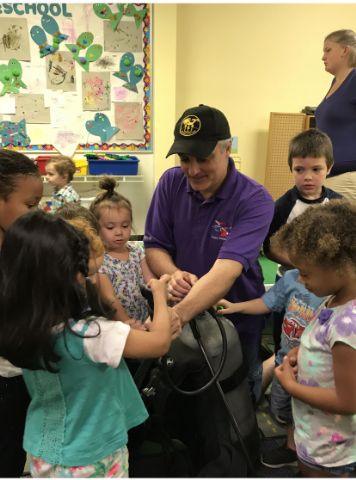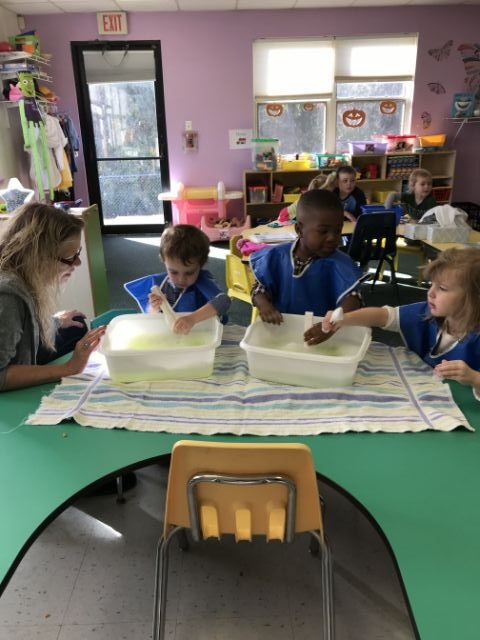Pre-preschool (Ages 3 to 4 years old)
Children use words as symbols for people, things, and their needs. They develop the ability to talk in sentences and experience self-control of their bodily functions. They begin to share and enjoy interactions with others. With positive encouragement, the sense of listening and following directions and advancement on small and large motor skills develop. Introduction of a variety of materials encourages them to explore the process of putting them together and see how it works. This promotes self-accomplishment. Story time encourages the ability to repeat and create their own stories.
Emotional Development
- Begin to assist with dressing self (e.g. jacket, hat, etc.)
- Care for some physical needs with supervision
- Follow basic daily routines with staff assistance
- Assist staff in putting some materials, toys, and equipment in the proper place with supervision
- Play alone and in small groups some of the time and which total group occasionally
- Deal with emotions in a way suitable for developmental level, most of the time
- Respond to praise and suggestions from others
- Make the transition from home to center with a minimum of anxiety
Physical Development
Gross Motor
- Perform simple loco motor tasks, including walking forward and backward, running, and jumping
- Walk a few steps on a line on the floor
- Throw a large ball at lest two feet
- Roll large and small balls
- Perform simple somersaults with assistance
- Manipulate large toys and wheeled equipment
- Use some of the playground equipment (e.g. slide)
- Begin to participate in simple group games
Fine Motor
- Construct simple block structures
- Stack at least three small objects (e.g. over two inches in diameter)
- Complete 3-5 piece puzzle
- Use crayons to create free-form designs
- Practice turning book pages one at a time
- Feed self using spoon and tumbler
- Place pegs in pegboard, shapes into shape box, etc.
- Begin to participate in simple group games
Cognitive Development
- Use words “big” and “little”
- Follow at least on direction
- Recognize and name two colors
- Identify familiar sounds in environment (e.g. car horn, baby cry, etc.)
- Identify major parts on own body
- Name some familiar animals and identify the sounds they make (e.g. ducks quack)
- Identify a missing part of an object in a picture (e.g. car without wheels)
- Identify functions of some familiar objects according to their use (e.g. furniture, food, clothing, etc.)
Language Development
- Recognize own name and the name of caregiver
- Give simple answers to questions
- Identify some common objects and familiar people when names are given by staff
- Name some familiar objects in his/her environment
- Pronounce most words correctly (except for some articulation errors)
- Express own needs and wants
- Repeat a few simple finger plays
- Relate a simple activity or event
Social Development & Living
- Participate in the total group some of the time
- Share in a small group some of the time
- Identify family members
- Cooperate most of the time
- Learn about some adult roles in the neighborhood (e.g. doctor, firefighter, etc.)
Reading Readiness
- Begin recognizing some letters of the alphabet
- Recognize simple, common story characters (e.g. the Three Bears)
- Tell what is happening in a simple picture
- Retell a part of a familiar story
- Listen to short stories
- Attend to films, filmstrips, puppet shows, etc., appropriate to developmental level
Science
- Show concern and care for animals
- Help plant and maintain simple plants (e.g. indoors and outdoors)
- Identify some textures (e.g. hard, soft, fuzz, etc.)
- Identify some foods according to taste
- Assist with a cooking experience
- Learn about some insects (e.g. butterfly, ant, etc.)
- Give simple descriptions of the weather (e.g. its’ raining, cloudy, hot, etc.)
Premath Skills
- Use simple number songs, rhymes, and finger pals
- Indicate age in numbers of fingers and verbally
- Rote count from 1-5
- Sort like shapes (e.g. triangles, circles, squares, etc.)
Art, Music, and Movement
- Assist staff with care of art materials
- Use some art media including crayons, markers, paints, and play dough
- Use paste with supervision
- Use various art techniques with supervision, including collage and painting
- Listen to music
- Participate in simple singing games and songs
- Use rhythm instruments
- March to music
- Use free-form movement and perform simple exercises to music



